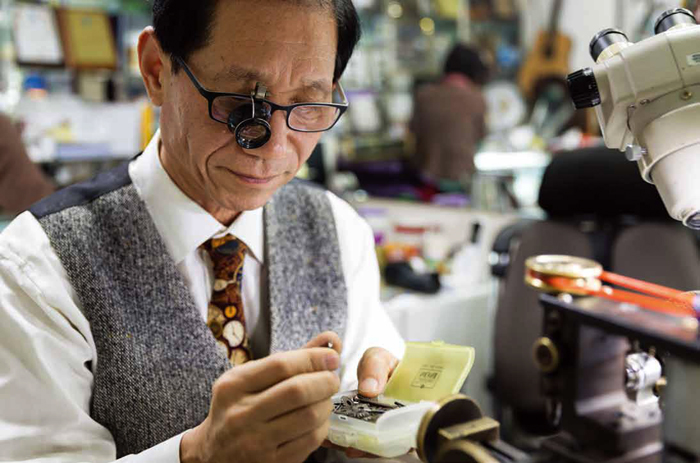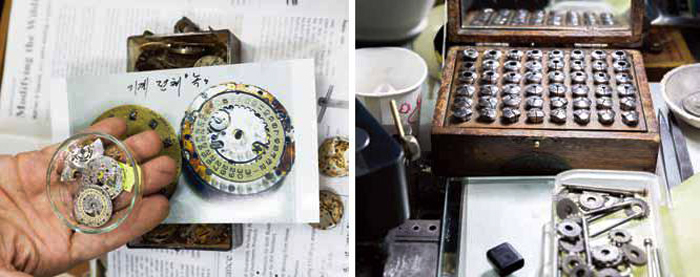View this article in another language
- 한국어
- English
- 日本語
- 中文
- العربية
- Español
- Français
- Deutsch
- Pусский
- Tiếng Việt
- Indonesian
“Time is money”—so the saying goes. Sometimes, though, it feels as if the two exist in an adversarial relationship and that money has just about defeated personal time. The same goes for timepieces.
Where a clock was once a fabulously expensive and exclusive possession, a highly accurate digital watch can now be bought for peanuts and has been rendered virtually obsolete by the inclusion of a time function on every device imaginable.

But the innards of a well-made analog watch remain a miracle of human ingenuity and precision. The interaction of tiny springs, cogs, dials and hands remains a work exclusive to a small number of highly qualified individuals. In East Asia, one of the few people who fall into this illustrious category is Back Jun-duk, a master craftsman working out of a small shop at a Daegu mall.
The lone watch repairman in East Asia accredited by the British Horological Institute, Back is to whom many desperate owners of high quality watches turn with problems when they have exhausted all other avenues.
“A Korean-Brazilian man recently flew here with his watch from Brazil,” he says. “He’d tried sending it to other countries for repair, but none of them could do it. I fixed it for him.” Despite being at the top of a highly specialized profession, Back remains disarmingly humble and clearly enjoys nothing more than his work.
Natural flair for mechanisms
Adverse circumstances forced Back to abandon his education after elementary school and seek work. “I started off by asking the boss of a lighter repair shop,” he says. “But he pretty much laughed me off. Lighters used a variety of mechanisms in those days. I managed to persuade him to give me one to fix on my own, which I did by fixing the cogs inside it. He was surprised.”
Back later got the manager of a watch repair shop in his hometown of Daegu to teach him. This only lasted for three months, however, but Back later spent several years improving his skills and grew more confident as a watchmaker.
“After 10 years, I lost my confidence,” he says. “I started feeling that I’d actually been damaging all the watches I fixed until then, and that I needed more theoretical knowledge.” Back studied at one of Korea’s two horological academies for six months, then began teaching there at the request of the director.

Afterwards, Back began seeking concrete recognition of his expertise. “I went to the Labor Ministry, but the department that used to deal with qualifications for craftsmen had closed,” he says. “I was too old to enter any of the domestic skills competitions. I joined the American Watchmakers Association, but that just meant I was a member and received its magazine. I sent a letter to Switzerland asking about certification, but it said it had no national accreditation system there and referred me instead to the British Horological Institute.”
After doing distance study, Back took the final exam and became one of only eight among some 300 highly skilled applicants to gain a top qualification. “I scored 80 percent in the practical section,” he says. “Nobody has done that since.”
Back demonstrates the tools of his trade, principally, the lathe and milling spindle. He shows examples of the latter that he has made himself, an esoteric device that in the right hands can be used to create minute cogwheels and other parts to tolerances of one thousandth of a millimeter, created entirely from brass rods.
Captivating skill
Seeing Back at work is mesmerizing, especially the skill and patience with which he takes apart watch mechanisms, makes new parts, heat-treats tiny, deformed springs back into shape and restores their elasticity. He is a one-man rebuttal to today’s overwhelming culture of disposable, low-quality materialism. As long as artisans like him are around, the mechanical miracle of the analog watch looks set to stay alive.
“I’ll keep doing this until the day I die,” he says.
* Article from Korea Magazine (January 2014)
Where a clock was once a fabulously expensive and exclusive possession, a highly accurate digital watch can now be bought for peanuts and has been rendered virtually obsolete by the inclusion of a time function on every device imaginable.
Master watch repairman Back Jun-duk
But the innards of a well-made analog watch remain a miracle of human ingenuity and precision. The interaction of tiny springs, cogs, dials and hands remains a work exclusive to a small number of highly qualified individuals. In East Asia, one of the few people who fall into this illustrious category is Back Jun-duk, a master craftsman working out of a small shop at a Daegu mall.
The lone watch repairman in East Asia accredited by the British Horological Institute, Back is to whom many desperate owners of high quality watches turn with problems when they have exhausted all other avenues.
“A Korean-Brazilian man recently flew here with his watch from Brazil,” he says. “He’d tried sending it to other countries for repair, but none of them could do it. I fixed it for him.” Despite being at the top of a highly specialized profession, Back remains disarmingly humble and clearly enjoys nothing more than his work.
Natural flair for mechanisms
Adverse circumstances forced Back to abandon his education after elementary school and seek work. “I started off by asking the boss of a lighter repair shop,” he says. “But he pretty much laughed me off. Lighters used a variety of mechanisms in those days. I managed to persuade him to give me one to fix on my own, which I did by fixing the cogs inside it. He was surprised.”
Back later got the manager of a watch repair shop in his hometown of Daegu to teach him. This only lasted for three months, however, but Back later spent several years improving his skills and grew more confident as a watchmaker.
“After 10 years, I lost my confidence,” he says. “I started feeling that I’d actually been damaging all the watches I fixed until then, and that I needed more theoretical knowledge.” Back studied at one of Korea’s two horological academies for six months, then began teaching there at the request of the director.
It takes many parts and tools to make a watch tick.
Afterwards, Back began seeking concrete recognition of his expertise. “I went to the Labor Ministry, but the department that used to deal with qualifications for craftsmen had closed,” he says. “I was too old to enter any of the domestic skills competitions. I joined the American Watchmakers Association, but that just meant I was a member and received its magazine. I sent a letter to Switzerland asking about certification, but it said it had no national accreditation system there and referred me instead to the British Horological Institute.”
After doing distance study, Back took the final exam and became one of only eight among some 300 highly skilled applicants to gain a top qualification. “I scored 80 percent in the practical section,” he says. “Nobody has done that since.”
Back demonstrates the tools of his trade, principally, the lathe and milling spindle. He shows examples of the latter that he has made himself, an esoteric device that in the right hands can be used to create minute cogwheels and other parts to tolerances of one thousandth of a millimeter, created entirely from brass rods.
Captivating skill
Seeing Back at work is mesmerizing, especially the skill and patience with which he takes apart watch mechanisms, makes new parts, heat-treats tiny, deformed springs back into shape and restores their elasticity. He is a one-man rebuttal to today’s overwhelming culture of disposable, low-quality materialism. As long as artisans like him are around, the mechanical miracle of the analog watch looks set to stay alive.
“I’ll keep doing this until the day I die,” he says.
* Article from Korea Magazine (January 2014)